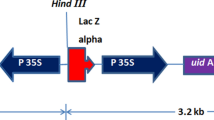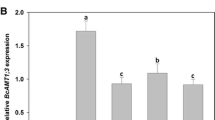Abstract
Transient expression of GUS in rice (Oryza sativa L.) mediated by Agrobacterium tumefaciens was characterized using binary vectors containing gusA genes that express minimal (pKIWI105 and pCNL1) or no (p35S-GUS-INT and pCNL56) GUS activity in bacteria. Four-day old seedlings obtained from seeds or immature embryos of rice were cut into shoot, root, and seed remnants and inoculated with various strains of A. tumefaciens. Transient GUS expression events were quantitated histochemically by determining the frequency of explants exhibiting blue spots indicative of GUS at four to six days after cocultivation with A. tumefaciens. A. tumefaciens strains that did not contain the gusA gene (At643) or a Ti-plasmid (At563 and At657) did not elicit any blue staining characteristic of GUS activity.
Several parameters were important in obtaining efficient transient expression of GUS in rice mediated by A. tumefaciens. The growth regulator 2,4-D inhibited GUS expression if present during the seed germination period, but the presence of 6 mg/1 2,4-D during cocultivation of the explants with A. tumefaciens slightly enhanced GUS expression efficiency. All 21 rice cultivars tested expressed GUS after co-cultivation with A. tumefaciens. The GUS expression frequency was highest amongst the indica cultivars. The frequencies of GUS expression in japonica cultivars and in Oryza glaberrima cultivars (grown primarily in Africa) were generally one-half to one-third the level found for indica varieties. Leaf explants were more susceptible to A. tumefaciens-facilitated GUS expression than were roots or seed remnants. The vir genes of an agropine-type Ti-plasmid of A. tumefaciens were most effective in directing transient GUS expression in rice, whereas those of a nopaline-type and an octopine-type plasmid were less effective. We have also found that the frequency of transient expression of GUS was higher with pBIN19 as the precursor cloning vector than with pEND4K as the precursor cloning vector. Reasons for differences in effectiveness of these binary vectors are discussed. Using the conditions described here, A. tumefaciens-mediated frequencies of transient GUS expression in four-day old shoots of several rice cultivars were routinely in excess of 50%.
Similar content being viewed by others
References
Bevan M: Binary Agrobacterium vectors for plant transformation. Nucl Acids Res 12: 8711–8721 (1984).
Boulton MI, Buchholz WG, Marks MS, Markham PG, Davies JW: Specificity of Agrobacterium-mediated delivery of maize streak virus DNA to members of the Gramineae. Plant Mol Biol 12: 31–40 (1989).
Bytebier B, Deboeck F, DeGreve H, VanMontagu M, Hernalsteens J.-P: T-DNA organization in tumor cultures and transgenic plants of the monocotyledon Asparagus officinalis. Proc Natl Acad Sci USA 84: 5345–5349 (1987).
Chilton MD, Currier TC, Farrand SK, Bendich AJ, Gordon MP, Nester EW: Agrobacterium tumefaciens DNA and PS8 bacteriophage DNA not detected in crown gall tumors. Proc Natl Acad Sci USA 71: 3672–3676 (1974).
Christou P, Ford TL, Kofron M: Production of transgenic rice (Oryza sativa L.) plants from agronomically important indica and japonica varieties via electric discharge particle acceleration of exogenous DNA into immature zygotic embryos. Bio/technology 9: 957–962 (1991).
Chu CC, Wang CC, Sun CS, Hsu C, Yin KC, Chu CY, Bin FY: Establishment of an efficient medium for anther culture of rice through comparative experiments on nitrogen sources. Scient Sin 18: 659–668 (1975).
Deblare R, Bytebier B, DeGreve H, Deboeck F, Schell J, VanMontagu M, Leemans J: Efficient octopine Ti-plasmid-derived vectors for Agrobacterium-mediated gene transfer to plants. Nucl Acids Res 13: 4777–4788 (1985).
DeCleene M, DeLey G: The host range of crown gall. Bot Rev 42: 389–466 (1976).
Depicker A, Stachel S, Dhaese P, Zambryski P, Goodman HM: Nopaline synthase: Transcript mapping and DNA sequence. J Mol Appl Genet 1: 561–573 (1982).
Ditta G, Stanfield S, Corbin D, Helinski DR: Broad host range DNA cloning system for Gram-negative bacteria: construction of a gene bank of Rhizobium meliloti. Proc Natl Acad Sci USA 77: 7347–7351 (1980).
Garfinkel DJ, Simpson RB, Ream LW, White FF, Gordon MP, Nester EW: Genetic analysis of Crown gall: fine structure map of the T-DNA by site-directed mutagenesis. Cell 27: 143–153 (1981).
Gordon-Kamm WJ, Spencer TM, Mangano ML, Adams TR, Daines RJ, Start WG, O'Brien JV, Chambers SA, Adams WR, Willetts NG, Rice TB, Mackey CJ, Krueger RW, Kausch AP, Lemaux PG: Transformation of maize cells and regeneration of fertile transgenic plants. Plant Cell 2: 603–618 (1990).
Gould J, Devey M, Hasegawa O, Ulian EC, Peterson G, Smith RH: Transformation of Zea mays L. using Agrobacterium tumefaciens and the shoot apex. Plant Physiol 95: 426–434 (1991).
Hodges TK, Peng JY, Lee L, Koetje DS: In vitro culture of rice: transformation and regeneration of protoplasts. In: Gustafson P (ed.) Gene Manipulation in Plant Improvement II, pp. 163–183. Plenum Press, New York (1990).
Hodges TK, Peng JY, Lyznik LA, Koetje DS: Transformation and regeneration of rice protoplasts. In: Kush GS, Toenniessen GH (eds) Rice Biotechnology, pp. 157–174. C.A.B International, Wallingford, UK (1991).
Hood EE, Fraley RT, Chilton MD: Virulence of Agrobacterium tumefaciens strain A281 on legumes. Plant Physiol 83: 529–534 (1987).
Hood EE, Helmer GL, Fraley RT, Chilton MD: The hypervirulence of Agrobacterium tumefaciens A281 is encoded in a region of pTiBo542 outside of T-DNA. J Bact 168: 1291–1301 (1986).
Hooykaas PJJ: Transformation of plant cells via Agrobacterium. Plant Mol Biol 13: 327–336 (1989).
Janssen BJ, Gardner RC: Localized transient expression of GUS in leaf discs following cocultivation with Agrobacterium. Plant Mol Biol 14: 61–72 (1989).
Jarchow E, Grimsley NH, Hohn B: virF, the host-range-determining virulence gene of Agrobacterium tumefaciens, affects T-DNA transfer to Zea mays. Proc Natl Acad Sci USA 88: 10426–10430 (1991).
Jefferson RA: Assaying chimeric genes in plants: The GUS gene fusion system. Plant Mol Biol Rep 5: 387–405 (1987).
Jen GC, Chilton MD: The right border region of pTiT37 T-DNA is intrinsically more active than the left border region in promoting T-DNA transformation. Proc Natl Acad Sci USA 83: 3895–3899 (1986).
Jin S, Komari T, Gordon MP, Nester EW: Genes responsible for the supervirulence phenotype of Agrobacterium tumefaciens A281. J Bact 169: 4417–4425 (1987).
Klee HS, Yanofsky MF, Nester EW: Vectors for transformation of higher plants. Bio/technology 3: 637–642 (1985).
Komari T: Transformation of cultured cells of Chenopodium quinoa by binary vectors that carry a fragment of DNA from the virulence region of pTiBo542. Plant Cell Rep 9: 303–306 (1990).
Marks MS, Kemp JM, Woolston CJ, Dale PJ: Agroinfection of wheat: a comparison of Agrobacterium strains. Plant Sci 63: 247–256 (1989).
Mooney PA, Goodwin PB, Dennis ES, Llewellyn DJ: Agrobacterium tumefaciens-gene transfer into wheat tissues. Plant Cell, Tissue and Organ Culture 25: 209–218 (1991).
Peralta EG, Hellmiss R, Ream W: Overdrive, a T-DNA transmission enhancer on the A. tumefaciens tumour-inducing plasmid. EMBO J 5: 1137–1142 (1986).
Raineri DM, Bottino P, Gordon MP, Nester EW: Agrobacterium-mediated transformation of rice (Oryza sativa L.). Bio/technology 8: 33–38 (1990).
Schafer W, Gorz A, Kahl G: T-DNA integration and expression in monocot crop plant after induction of Agrobacterium. Nature 327: 529–532 (1987).
Sciaky D, Montoya AL, Chilton MD: Fingerprints of Agrobacterium Ti-plasmids. Plasmid 1: 238–253 (1978).
Toro N, Datta A, Carmi OA, Young C, Prusti RK, Nester EW: The Agrobacterium tumefaciens virC1 gene product binds to overdrive, a T-DNA transfer enhancer. J Bact 171: 6845–6849 (1989).
Vancanneyt G, Schmidt R, O'Connor-Sanchez A, Willmitzer L, Rocha-Sosa M: Construction of an introncontaining marker gene: Splicing of the intron in transgenic plants and its use in monitoring early events in Agrobacterium-mediated plant transformation. Mol Gen Genet 220: 245–250 (1990).
VanLarebeke N, Engler G, Holstters M, Van denElsacker S, Zaenen I, Schilperoort RA, Schell J: Large plasmid in Agrobacterium tumefaciens essential for crown gall-inducing ability. Nature 252: 169–170 (1974).
Veluthambi K, Ream W, Gelvin SB: Virulence genes, borders and overdrive generate single-stranded T-DNA molecules from the A6 Ti plasmid of Agrobacterium tumefaciens. J Bact 170: 1523–1532 (1988).
Wang K, Genetello C, VanMontagu M, Zambryski PC: Sequence context of the T-DNA border repeat element determines its relative activity during T-DNA transfer to plant cells. Mol Gen Genet 210: 338–346 (1987).
Watson B, Currier TC, Gordon MP, Chilton MD, Nester EW: Plasmid required for virulence of Agrobacterium tumefaciens. J Bact 123: 255–264 (1975).
Author information
Authors and Affiliations
Rights and permissions
About this article
Cite this article
Li, XQ., Liu, CN., Ritchie, S.W. et al. Factors influencing Agrobacterium-mediated transient expression of gusA in rice. Plant Mol Biol 20, 1037–1048 (1992). https://doi.org/10.1007/BF00028891
Received:
Accepted:
Issue Date:
DOI: https://doi.org/10.1007/BF00028891




